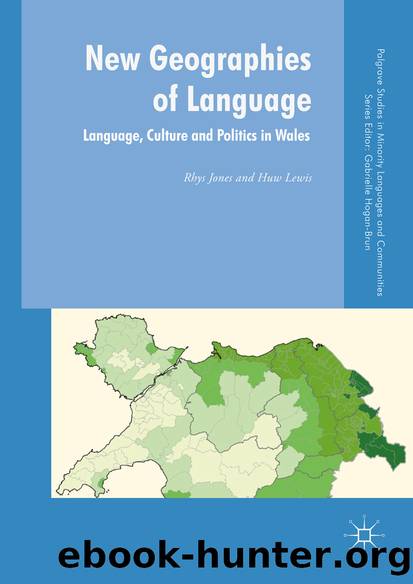New Geographies of Language by Rhys Jones & Huw Lewis

Author:Rhys Jones & Huw Lewis
Language: eng
Format: epub
ISBN: 9781137426116
Publisher: Palgrave Macmillan UK
And of course, there is another fundamental geographical omission in this long-term Strategy, as one leading commentator has discussed with us; given the high levels of out-migration of Welsh speakers from Wales, an overall total of approximately 1.3 million Welsh speakers will need to exist by 2050 in order for the Welsh Government to reach its goal of reaching one million Welsh speakers in Wales by the same year (interview, November 2017). It is doubtful whether the Welsh Government have fully considered this issue but, in broader terms, it reinforces the lack of geographical vision that accompanies the most recent Strategy document.
The second more prospective aspect of Welsh-language policy-making revolves around devising proactive interventions that will help to mitigate against some of the specific challenges facing the Welsh language. One of the most pertinent examples of seeking to devise proactiveâand preventativeâapproaches to dealing with the challenges facing the language has been in relation to town and country planning. As discussed in Sect. 4.2, a number of different processesâespecially an out-migration of Welsh speakers from, and an in-migration of non-Welsh speakers to, Y Fro Gymraegâhas led to a marked decline in the percentages of Welsh speakers in some communities. It is in this context the Welsh Office (1988) and, latterly, the Welsh Government, along with some local authorities (e.g. Gwynedd County Council 1988) and National Park Authorities, have attempted to develop mechanisms for assessing the potential impact of new developments on the social and cultural fabric of communities in which the Welsh language is widely spoken (e.g. National Assembly for Wales 2002; Gallent et al. 2002). Technical Advice Note (TAN) (Wales) 20 has assumed a prominent role in discussions of the impact of the planning system on the Welsh language. The most recent iteration, for instance, states that development plans produced by local planning authorities should consider how âthe strategy and policies are likely to impact on use of the Welsh language and the sustainability of communitiesâ (Welsh Government 2017d: 5). Despite the existence of such statements and guidance, it is clear that the substantive impact of TAN 20 on planning considerations has been limited. While local development plans contain discussion of the significance of the Welsh language to the fabric of communities within the areas that they govern, there is very little evidence to show that TAN 20 has helped to amend or halt specific developments because of the potential detrimental effect that they will have on the Welsh-language (Lo Piccolo and Thomas 2001; Gallent et al. 2002). Local planning authorities, in this respect, have maintained that TAN 20 does not provide a sufficiently robust mechanism for them to predict the impact of a proposed development on the Welsh language.
In broad terms, the above discussion illustrates some of the practical difficulties that attend predicting the impacts of developments on the future vitality of the Welsh language. A recent project, however, has sought to use basic GIS in order to predict the impact that large infrastructure projects might have on the Welsh language.
Download
This site does not store any files on its server. We only index and link to content provided by other sites. Please contact the content providers to delete copyright contents if any and email us, we'll remove relevant links or contents immediately.
| Anthropology | Archaeology |
| Philosophy | Politics & Government |
| Social Sciences | Sociology |
| Women's Studies |
Cecilia; Or, Memoirs of an Heiress — Volume 1 by Fanny Burney(32437)
Cecilia; Or, Memoirs of an Heiress — Volume 2 by Fanny Burney(31873)
Cecilia; Or, Memoirs of an Heiress — Volume 3 by Fanny Burney(31857)
The Great Music City by Andrea Baker(31516)
We're Going to Need More Wine by Gabrielle Union(18972)
All the Missing Girls by Megan Miranda(15588)
Pimp by Iceberg Slim(14398)
Bombshells: Glamour Girls of a Lifetime by Sullivan Steve(13977)
Talking to Strangers by Malcolm Gladwell(13231)
Norse Mythology by Gaiman Neil(13211)
Fifty Shades Freed by E L James(13161)
For the Love of Europe by Rick Steves(13069)
Mindhunter: Inside the FBI's Elite Serial Crime Unit by John E. Douglas & Mark Olshaker(9206)
Crazy Rich Asians by Kevin Kwan(9171)
The Lost Art of Listening by Michael P. Nichols(7411)
Enlightenment Now: The Case for Reason, Science, Humanism, and Progress by Steven Pinker(7239)
The Four Agreements by Don Miguel Ruiz(6637)
Bad Blood by John Carreyrou(6558)
Weapons of Math Destruction by Cathy O'Neil(6149)
